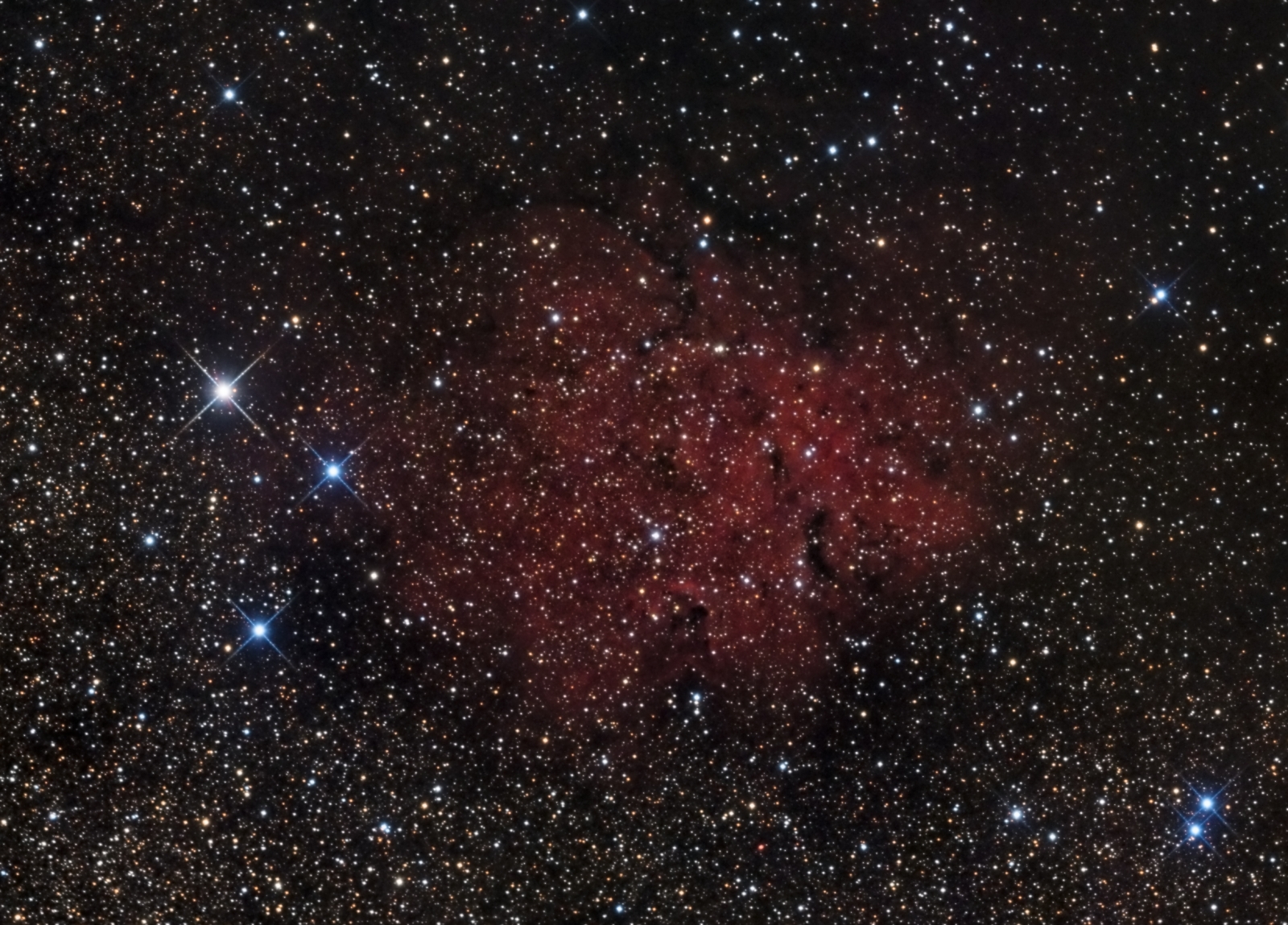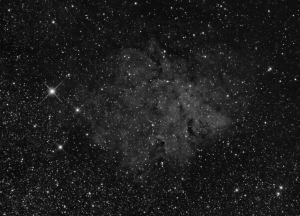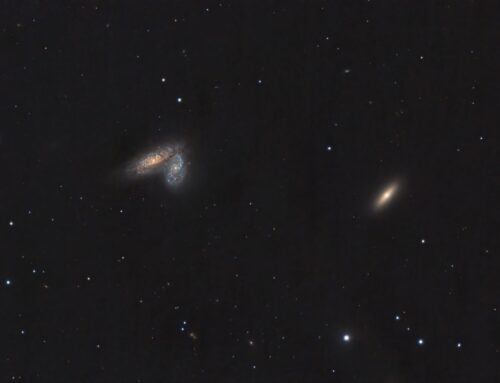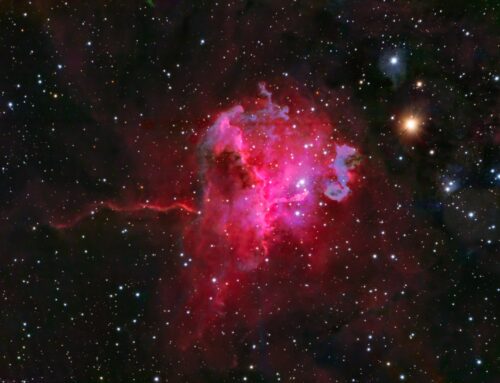Sh2-72 Emission Nebula
 Click image for full size version
Click image for full size version
July 21, 2016
Sh2-72 is an emission nebula in Aquila, the Eagle, and lies about 5,870 light years away in a rich star field. This object also goes by the catalogue number RCW179. There appears to be some active star formation going on in this gas cloud based on infrared observations. Like other emission nebulae, the red colour of Sh2-72 comes from hydrogen atoms releasing energy as red light. The varied star colours indicate their temperatures: hot stars are blue and white; the coolest stars are reddish.
 This image blends the red, green and blue colour channels with data collected through a deep red H-alpha filter. The black and white image at right shows just the H-alpha data alone. A full size image is available by clicking on the image.
This image blends the red, green and blue colour channels with data collected through a deep red H-alpha filter. The black and white image at right shows just the H-alpha data alone. A full size image is available by clicking on the image.
I have been shooting dim members of the Sharpless catalogue over the last few months. They are challenging to image (actually, to process), since detail is subtle and the targets I’ve chosen are very faint. But that is half the fun!
Tekkies:
SBIG STL-11000M camera, Baader Ha, R, G and B filters, 10″ f/6.8 ASA astrograph, Paramount MX. Guided with QHY5 guide camera and 80 mm f/6 Stellar-Vue refractor. Acquisition, guiding and mount control with TheSkyX. Focusing with FocusMax. Automation with CCDCommander. All preprocessing and post-processing in PixInsight. Shot from my SkyShed in Guelph, Ontario. Nearly full Moon for Ha and first quarter moon for RGB. Good to excellent transparency and average to very good seeing throughout acquisition.
4x15m R, 4x15mG, 4x15mB and 36x20m Ha unbinned frames (total=15hr).
HaRGB
Creation and cleanup: Ha, R, G and B masters were cropped and processed separately with DBE. R, G and B were combined to make an RGB image which was processed with ColourCalibration. The NB-RGBCombine Script was applied with default settings to produce a linear HaRGB image.
Linear Noise Reduction: MultiscaleLinearTransform was used to reduce noise in the background areas. Layer settings for threshold and strength: Layer 1: 3.0, 0.5 Layer 2: 2.0, 0.35 Layer 3: 1.0, 0.2 Layer 4: 0.5, 0.1
Stretching: HistogramTransformation was applied to make a pleasing yet bright image. TGV Noise was applied and the image was re-stretched to reset the black point.
Synthetic Luminance and H-alpha only:
Creation and cleanup of SynthL: The cleaned up Ha, R,G and B masters were combined using the ImageIntegration tool (average, additive with scaling, noise evaluation, iterative K-sigma / biweight midvariance, no pixel rejection).
Deconvolution: A copy of the image was stretched to use as a deconvolution mask. A star mask was made from unstretched SynthL to use as a local deringing support. Deconvolution was applied (80 iterations, regularized Richardson-Lucy, external PSF made using DynamicPSF tool with about 20 stars; local deringing at 70% and global dark deringing at 0.03).
Linear Noise Reduction: MultiscaleLinearTransform was applied to reduce the noise. Layer settings for threshold and strength: Layer 1: 3.0, 0.5 Layer 2: 2.0, 0.35 Layer 3: 1.0, 0.2 Layer 4: 0.5, 0.1
Stretching: HistogramTransformation was applied to make a pleasing yet bright image. TGV Noise was applied and the image was re-stretched to reset the black point.
HDR Multiscale Transformation: HDRMT was applied at a 6 pixel scale using a mask to protect stars. LHE was applied at scales of 50 and 150 using the same star mask (Contrast limit 1.5 and strength 0.25 for both).
Combining SynthL with HaRGB:
The luminance channel of the HaRGB image was extracted, processed and then added back into the HaRGB image as follows:
1. Extract luminance from the HaRGB image.
2. Apply LinearFit using SynthL as the reference.
3. Use ChannelCombination in Lab mode to replace the HaRGB’s luminance with the fitted luminance from step 2.
4. LRGBCombine was then used to make a SynthLHaRGB image.
Final Processing of HaRGB and H-alpha only:
Background, stars and nebula brightness and contrast (HaRGB and Ha-only), and saturation (HaRGB) were adjusted in several iterations using masks as required. The DarkStructureEnhance script was applied with a scale of 8 and strength of 0.3.
Image scale is about 1.1 arcsec per pixel for this camera / telescope combination.






Ron – just a word of thanks for sharing your processing steps. I have not yet done so…..but may just follow some of your steps in the future to refine my crude way of going about things. I always look in on your posts on PI site……lack of comment does not equate to lack of appreciation 🙂
Thank you! Did you see my article in the August 2016 Sky & Telescope? It describes my PI workflow in some detail. If you can’t get a copy, just hang on a couple of weeks. I’ll be posting a .pdf file on my site at the end of July.
Hi Ron…..thanks for the heads up re your workflow…..have not seen the article simply because I don’t buy or subscribe to any ‘mags’. Looking forward to seeing it on your site later.